初中英语阅读课教案集
初中英语阅读课教案(热门5篇)
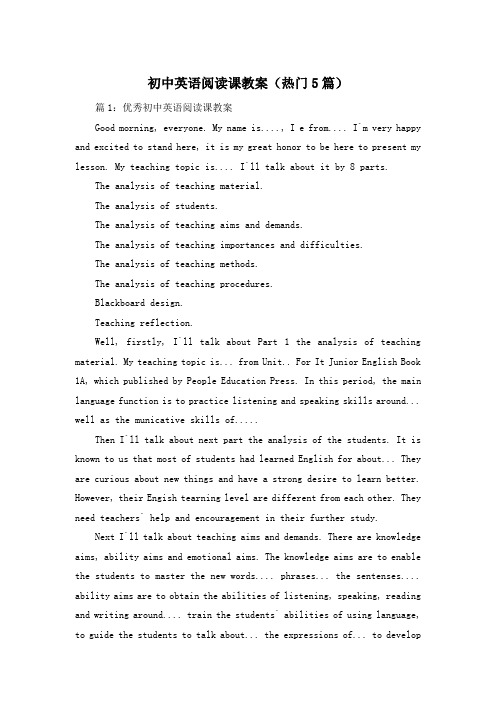
初中英语阅读课教案(热门5篇)篇1:优秀初中英语阅读课教案Good morning, everyone. My name is...., I e from.... I`m very happy and excited to stand here, it is my great honor to be here to present my lesson. My teaching topic is.... I`ll talk about it by 8 parts.The analysis of teaching material.The analysis of students.The analysis of teaching aims and demands.The analysis of teaching importances and difficulties.The analysis of teaching methods.The analysis of teaching procedures.Blackboard design.Teaching reflection.Well, firstly, I`ll talk about Part 1 the analysis of teaching material. My teaching topic is... from Unit.. For It Junior English Book 1A, which published by People Education Press. In this period, the main language function is to practice listening and speaking skills around... well as the municative skills of.....Then I`ll talk about next part the analysis of the students. It is known to us that most of students had learned English for about... They are curious about new things and have a strong desire to learn better. However, their Engish tearning level are different from each other. They need teachers` help and encouragement in their further study.Next I`ll talk about teaching aims and demands. There are knowledge aims, ability aims and emotional aims. The knowledge aims are to enable the students to master the new words.... phrases... the sentenses.... ability aims are to obtain the abilities of listening, speaking, reading and writing around.... train the students` abilities of using language, to guide the students to talk about... the expressions of... to developthe students` ability of creative thinking and cooperative study. The emotional aims are to enable.....Let`s move on to another part: the analysis of teaching importances and difficulties. The teaching importances are... teaching difficulties are.....Next is teaching methods. I use.. in my lesson. There are multimedia puter assisted instruction, task-based activities, situational approach, total physical response or the audio-lingual method.Now I`ll talk about teaching procedures. According to five steps teaching method, I design my lesson into five steps.Step 1 is warm-up. Here I`ll... this, the students can be interested in it and pay their attention to our class easily and....Step 2 is lead-in. Here I`ll... this, the students.....Step 3 is presentation. Here I`ll.... this, the students...... Step 4 is practice. Here I`ll... this, the students......Step 5 is homework. Here I`ll..... this ,the students.....Next is my blackboard design. I`ll design it like this.....At last, I want to say, to be a good teacher is my dream. I think a teacher is not only a guide for sudents, but also a friend of them. If I were a teacher, I would build a close relation with my students, helping them not only on their study but also on their lives. I`ll try my best, and I have confident that I can do it.Ok, that`s all. Thanks for your listening. Good-bye.篇2:优秀初中英语阅读课教案Unit 10 Where did you go on vacation?Good morning, everyone. I am from the . I have taught English for over ten years and I like my students. Today, I will talk about Unit 10 where did you go on vacation? Go for it Junior English Book are 6 periodsto finish this unit. I will talk about the first period with the following parts..I. Analysis of the Teaching Materials.The topic of this unit is the continuation of unit 9 as well as about the past events.By using the Simple PasT Tense,which is essential in junior English,students willtalk about their topic is about their experiences and places they havevisited on their it helps bring back their memories and learning motivations.II. Students’ characteristicAlthough the Junior 1 has been learning English for almost a year and are havingsome basic knowledge. Because of living in China and surrounding environment, students are learning English impassively and irregularly. But The junior 1 has showned themselves very creative,capable and of plasticity as they’re doing so well in what they’re interested in such as games and CAI.Aims and Demandsobjectivesa. To enable the students to read, to spell , to understand the vocabulary correctly.b. To help the students ask and answer the new sentence pattern: Where did you go on vacation?objectives.a. To improve the students’ skills of listening ,speaking,reading and writing..b. To encourage the students to municate with others uning the newsentence pattern .objectivesa. To train the Ss to cooperate well in groups and in pairs.b. To be interested in municating in English.IV. Teaching Key Points1. Key vocabularyNew York City camp summer camp museum2. Key structuresWhere did you go on vacation?I went to…V. Teaching DifficultyLearn the key structuresVI. Teaching Methods1. Task-based methodThat’s to say I’ll let the students finish 1 listening task and make short dialogues along with the actions to help the students get a better understanding of the keystructures.2. munication methodI’ll set up a dream and ask students to pretent themse lves as reporters. This way, the students can say freely and needn’t to worry about making mistakes.VII. Learning Methods1. Listening—speaking method2. municative strategyWe all know that the best ways to learn English well are to imitate,to practice,to listen,to speak and to municate more constantly.VIII. Teaching AidsIn this lesson, the CAI, cassette, a tape recorder will be used.X. Teaching ProcedureI’ll mainly talk about this part. It consists of 5 steps.Step 1 Warm – up and review1. Make a free talk between T-S. What did you do yesterday? And what did your best friend do yesterday?2. Write down the past tenses of the verbs that I show in CAI.Purpose: this step is in order to review what the students have learnt in Unit way, I can lead them into the new lesson smoothly. I think It’s usual but pratical.Step 2 Presentation1. Learn the new words and expressionsa. lead—in: ask students some questions: Did you dream last night? What did you dream? Where did I go on vacation in my dream?b. CAI shows many pictures of my dream,which are also the activities in 1a .c. Ask students to read and spell the new phrases.d. Do 1a. Match the activities with the pictures (a—g).e. Play a guessing game: I will show some jigsaws of each picture and have the students to guess. I will praise the student who answers more quickly.Purpose: I put the vocabulary learning into a dream in order to prompt them to find it very interesting to learn English.. By CAI, students can match the vocabulary with the real things directly and master them easily. Step 3 Listening practicea. Tell the students to listen to the tape and number the people (1—5) in the picture.b. Play the recorder for the first time, and then check the answers.c. Play the recorder again, students imitate the conversations and fill in the blanks. Pay attention to their pronunciation and intonation.Purpose: this is a basic and necessary step, which develops the students’ skills of listening, reading and writing.Step 4 Pairworka. T—S: where did Tina go on vacation?She went to the mountains.b. Ask the students to practice in pairs as we 1c. Then they will e to the platform and click on the number to choose a picture and act it out randomlyPurpose: “Task-based”teaching method is used here to develop the students’ability ofmunication and their ability of co-operation will be well trained. This step provides guided oral practice using the target language to consolidate the key structure and It can develop students’ skill of speaking and sense of language.Step5 ProductionHave students pretent to be reporters to interview anyone they want to ask about their vacation.Purpose: After learning 1a—1c, it’s time to extend what they learnt just now and give the students a free space to show their abilities. With the real situations, students will feel easy and successful during this part. By way of munication, the students will understand how to use the key structure better and consolidate the knowledge firmly.Part XI HomeworkDo a survey and write a report about the classmates’ vocation. Purpose: I think homework is so important that the students can speak english as much as they can in class or after set this step in order to practice students’ skills of listening, speaking and writing.Blackboard Design篇3:优秀初中英语阅读课教案教学目标教学目标Aim 记忆物品pants , socks , T-shirt , shirt , shorts , sweater , shoes理解颜色理解:color , black , white , red , green , blue ,应用通过布置任务,让学生在合作中进行语言交流。
初中九年级英语阅读理解教案
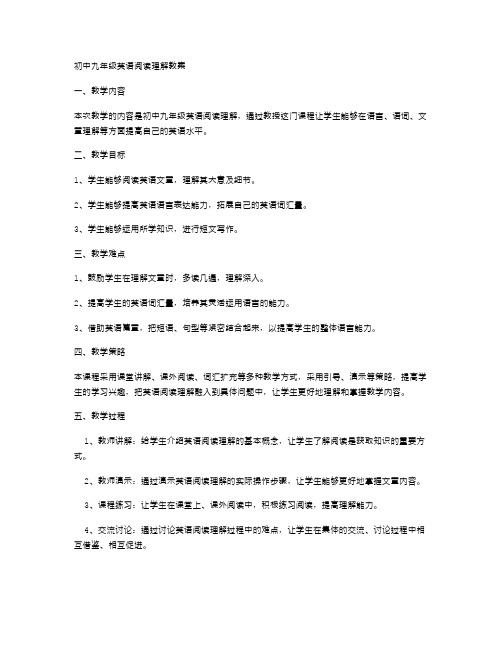
初中九年级英语阅读理解教案一、教学内容本次教学的内容是初中九年级英语阅读理解,通过教授这门课程让学生能够在语言、语词、文章理解等方面提高自己的英语水平。
二、教学目标1、学生能够阅读英语文章,理解其大意及细节。
2、学生能够提高英语语言表达能力,拓展自己的英语词汇量。
3、学生能够运用所学知识,进行短文写作。
三、教学难点1、鼓励学生在理解文章时,多读几遍,理解深入。
2、提高学生的英语词汇量,培养其灵活运用语言的能力。
3、借助英语篇章,把短语、句型等紧密结合起来,以提高学生的整体语言能力。
四、教学策略本课程采用课堂讲解、课外阅读、词汇扩充等多种教学方式,采用引导、演示等策略,提高学生的学习兴趣,把英语阅读理解融入到具体问题中,让学生更好地理解和掌握教学内容。
五、教学过程1、教师讲解:给学生介绍英语阅读理解的基本概念,让学生了解阅读是获取知识的重要方式。
2、教师演示:通过演示英语阅读理解的实际操作步骤,让学生能够更好地掌握文章内容。
3、课程练习:让学生在课堂上、课外阅读中,积极练习阅读,提高理解能力。
4、交流讨论:通过讨论英语阅读理解过程中的难点,让学生在集体的交流、讨论过程中相互借鉴、相互促进。
5、复习总结:通过课后写作、课程小测、期末考试等形式,对学生进行综合性复习、总结和巩固。
六、教学评价学生通过本次课程学习,能够对英语文章进行深入理解,对英语语言的表达也有了更深入的认识和理解。
学生对于英语阅读、短文写作等方面的学习也得到了提高,这对于他们以后的英语学习和应用都是非常有帮助的。
七、教学建议对于英语阅读理解课程,教师可以适当添加一些生活中的实际案例,以吸引学生的注意力,增加学生的学习兴趣。
此外,教师可以采用一些互动式教学方法,更好地调动学生的积极性和主动性,让学生在学习中更加愉快。
(英语教案)优秀初中英语阅读课教案
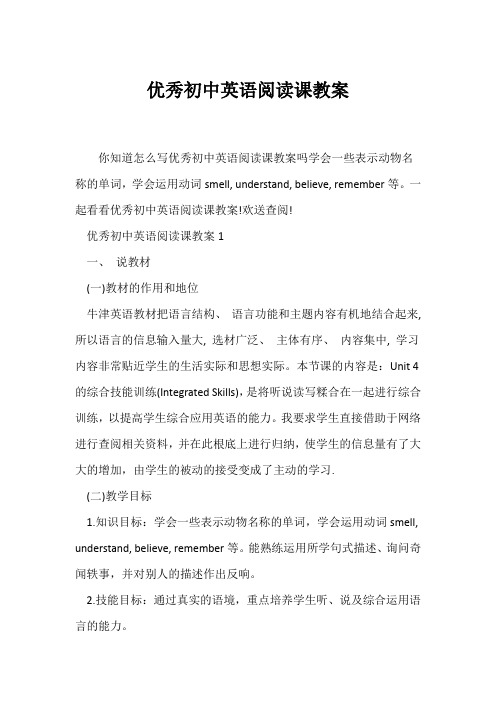
优秀初中英语阅读课教案你知道怎么写优秀初中英语阅读课教案吗学会一些表示动物名称的单词,学会运用动词smell, understand, believe, remember等。
一起看看优秀初中英语阅读课教案!欢送查阅!优秀初中英语阅读课教案1一、说教材(一)教材的作用和地位牛津英语教材把语言结构、语言功能和主题内容有机地结合起来, 所以语言的信息输入量大, 选材广泛、主体有序、内容集中, 学习内容非常贴近学生的生活实际和思想实际。
本节课的内容是:Unit 4 的综合技能训练(Integrated Skills),是将听说读写糅合在一起进行综合训练,以提高学生综合应用英语的能力。
我要求学生直接借助于网络进行查阅相关资料,并在此根底上进行归纳,使学生的信息量有了大大的增加,由学生的被动的接受变成了主动的学习.(二)教学目标1.知识目标:学会一些表示动物名称的单词,学会运用动词smell, understand, believe, remember等。
能熟练运用所学句式描述、询问奇闻轶事,并对别人的描述作出反响。
2.技能目标:通过真实的语境,重点培养学生听、说及综合运用语言的能力。
3.情感目标:培养学生的参与意识、竞争意识和合作精神,激发学生对我们所处的世界的热爱和不断探索未知世界的兴趣。
二、说教法(一)教学设计的原那么1 坚持自主学习,合作学习的教学原那么教师打破了以教师为中心, 单项灌输的陈旧模式, 在课堂教学中尽可能发挥学生的主动性和合作精神, 营造了良好的学习气氛, 更重要的是在频繁的交流中, 学生的语言表达能力提高了。
2 遵循英语教学的交际性原那么交际性原那么是英语教学中的一个指导性原那么, 教学最终的目的不仅要使学生掌握知识, 更重要的是使学生在理解的根底上, 在交际性练习中培养交际能力,而培养这种交际能力, 就是反映在课堂教学中学生以主人翁态度, 积极、主动、大胆地参与英语课堂练习活动的主体意识上。
初中英语阅读课教学设计(精选6篇)
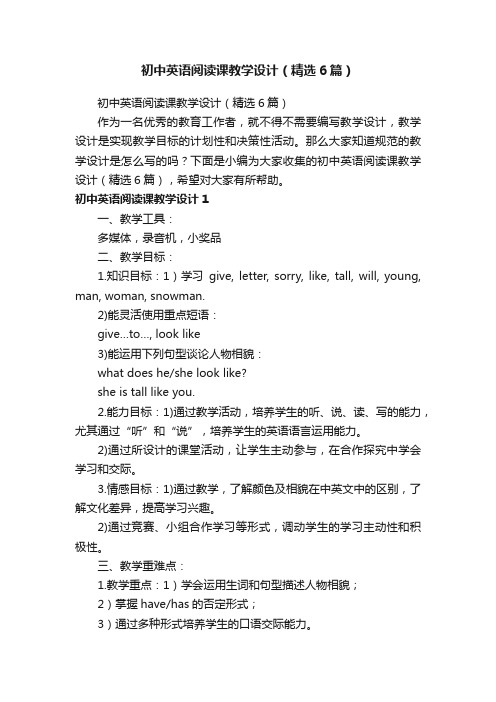
初中英语阅读课教学设计(精选6篇)初中英语阅读课教学设计(精选6篇)作为一名优秀的教育工作者,就不得不需要编写教学设计,教学设计是实现教学目标的计划性和决策性活动。
那么大家知道规范的教学设计是怎么写的吗?下面是小编为大家收集的初中英语阅读课教学设计(精选6篇),希望对大家有所帮助。
初中英语阅读课教学设计1一、教学工具:多媒体,录音机,小奖品二、教学目标:1.知识目标:1)学习give, letter, sorry, like, tall, will, young, man, woman, snowman.2)能灵活使用重点短语:give…to…, look like3)能运用下列句型谈论人物相貌:what does he/she look like?she is tall like you.2.能力目标:1)通过教学活动,培养学生的听、说、读、写的能力,尤其通过“听”和“说”,培养学生的英语语言运用能力。
2)通过所设计的课堂活动,让学生主动参与,在合作探究中学会学习和交际。
3.情感目标:1)通过教学,了解颜色及相貌在中英文中的区别,了解文化差异,提高学习兴趣。
2)通过竞赛、小组合作学习等形式,调动学生的学习主动性和积极性。
三、教学重难点:1.教学重点:1)学会运用生词和句型描述人物相貌;2)掌握have/has的否定形式;3)通过多种形式培养学生的口语交际能力。
2.教学难点:1)have/has的否定形式的教学;2)上课如何调动学生积极性。
四、教学过程step 1 warm up:enjoy a songreview the words about colors.t: we enjoyed a song just now. we have learned some words about color in section a. now please answer my questions.1) what color is it?2) how do you spell it?step 2 presentation1.lead in 3.talk about the colors of some national flags. finish 3.t: what color is the national flag?where is he/she from?what color is his/her hair?what color are his/her eyes?t: do pair works. then ask some pairs to act it out.2. lead in 2.teach “what does he/she look like?”(show another two pictures of women)(teach new words and phrases: look like, tall, man, woman, young.)t: what does the woman look like?ss: she is young. she has short blond hair and a small nose.t: what does the man look like?ss: he is old. he doesn?t have gray hair. his hair is black.(show the four pictures in part 2.)t: turn to page 35, look part 2. match the descriptions with the pictures.(ss match them)t: let?s check the answers.t: do pair works, ask and answer according to the four pictures.3. pair work: talk about the pictures, finish 2.step 3 look, listen and say1.(拿出事先准备好的一个学生的书。
初中生_英语阅读教案
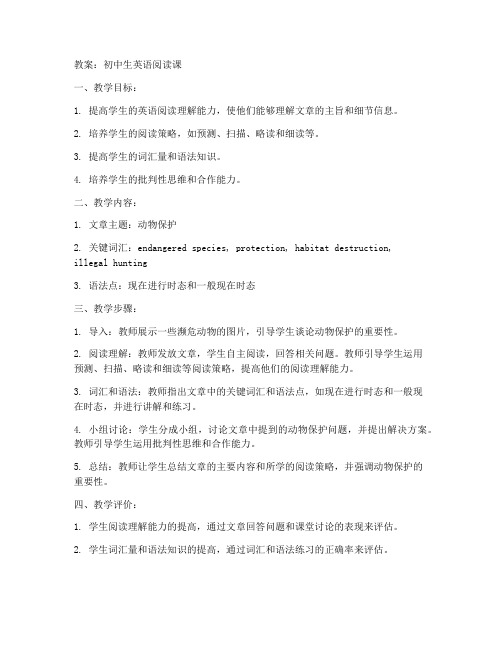
教案:初中生英语阅读课一、教学目标:1. 提高学生的英语阅读理解能力,使他们能够理解文章的主旨和细节信息。
2. 培养学生的阅读策略,如预测、扫描、略读和细读等。
3. 提高学生的词汇量和语法知识。
4. 培养学生的批判性思维和合作能力。
二、教学内容:1. 文章主题:动物保护2. 关键词汇:endangered species, protection, habitat destruction,illegal hunting3. 语法点:现在进行时态和一般现在时态三、教学步骤:1. 导入:教师展示一些濒危动物的图片,引导学生谈论动物保护的重要性。
2. 阅读理解:教师发放文章,学生自主阅读,回答相关问题。
教师引导学生运用预测、扫描、略读和细读等阅读策略,提高他们的阅读理解能力。
3. 词汇和语法:教师指出文章中的关键词汇和语法点,如现在进行时态和一般现在时态,并进行讲解和练习。
4. 小组讨论:学生分成小组,讨论文章中提到的动物保护问题,并提出解决方案。
教师引导学生运用批判性思维和合作能力。
5. 总结:教师让学生总结文章的主要内容和所学的阅读策略,并强调动物保护的重要性。
四、教学评价:1. 学生阅读理解能力的提高,通过文章回答问题和课堂讨论的表现来评估。
2. 学生词汇量和语法知识的提高,通过词汇和语法练习的正确率来评估。
3. 学生批判性思维和合作能力的提高,通过小组讨论的表现和提出的解决方案来评估。
五、教学资源:1. 文章:关于动物保护的英文文章。
2. 图片:濒危动物的图片。
3. 词汇和语法练习:相关的练习题。
六、教学时间:1课时(40分钟)七、教学建议:1. 在课堂上鼓励学生积极参与,提高他们的自信心和兴趣。
2. 针对不同学生的水平,可以适当调整教学内容和难度。
3. 鼓励学生在课后进行自主阅读,扩大词汇量和提高阅读能力。
4. 注重培养学生的批判性思维和合作能力,提高他们的综合素养。
初中英语阅读优秀教学教案范文5篇
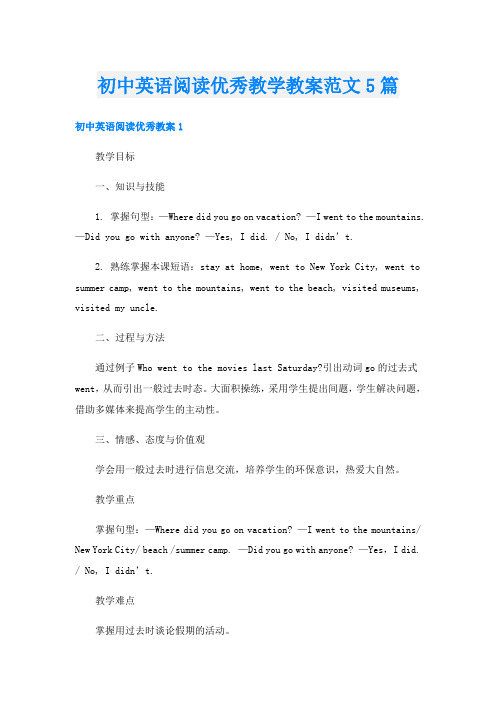
初中英语阅读优秀教学教案范文5篇初中英语阅读优秀教案1教学目标一、知识与技能1. 掌握句型:—Where did you go on vacation? —I went to the mountains. —Did you go with anyone? —Yes, I did. / No, I didn’t.2. 熟练掌握本课短语:stay at home, went to New York City, went to summer camp, went to the mountains, went to the beach, visited museums, visited my uncle.二、过程与方法通过例子Who went to the movies last Saturday?引出动词go的过去式went,从而引出一般过去时态。
大面积操练,采用学生提出间题,学生解决问题,借助多媒体来提高学生的主动性。
三、情感、态度与价值观学会用一般过去时进行信息交流,培养学生的环保意识,热爱大自然。
教学重点掌握句型:—Where did you go on vacation? —I went to the mountains/ New York City/ beach /summer camp. —Did you go with anyone? —Yes,I did. / No, I didn’t.教学难点掌握用过去时谈论假期的活动。
教法导航通过看图、看视频、听录音、问答、讨论等方法学习谈论能力和表达愿望。
学法导航通过看、听、说等各种途径,以小组合作的形式,主动探求知识,锻炼自主学习能力。
教学准备图片,多媒体。
教学过程Step 1 GreetingsGreet the class.Step 2 Lead inAsk questions about what students did last Saturday.(1)Who went to the movies last Saturday? Point to one student who raises his or her hand. Sara went to the movies last Saturday. Repeat.Write this sentence on the board.Underline the word went.(2)Ask:Who visited a friend last Saturday?Point to one student who raises his or her hand.Carlos visited a friend last Saturday.Repeat. Write this sentence on the board. Underline the word “visited”.Point to the words went and visited in the sentences on the board.Say:We use these words to talk about things that happened in the past. Writethese pairs of words on the board:go–went, visit –visited. Ask: Can you point out the words that talk about the past?This activity introduces the key vocabulary.Step 3 Practice1. Focus attention on the picture.Ask: What can you see?Say: Each picture shows something a person did in the each activity and ask students to repeat: went to the mountains, went to New York City, went to summer camp, visited my uncle,stayed at home, went to the beach, visited museums.2.Point to the numbered list of activities.Say each one again and ask the students to repeat.3.Now, please match each phrase with one of the pictures.Say:Write the letter of each picture next to the name of the activity.Point to the sample answer.4.Check the answers.Step 4 Listening1.Point to the picture on the screen. Say: look at Picture A,Where did Tina go on vacation? Yes,she went to the mountains.Ask:What did the person do in each scene? Say: There are three conversations. Play the recording the first time.2. The people talk about what they did on vacation.Listen to the recording and write numbers of the names in the right boxes in the picture.Please write only 5 numbers. Point out the sample answer next to the picture showing went to the mountain. Play the recording a second time.3.Correct the answers.Step 5 Pair workPoint out the example conversation. Ask two students to read the dialogue to the class. Say the dialogue in the picture with a student,Do a second example to the class. Then say:Now work with a partner, make conversations about the people in the pictures.As they talk,move around the classroom monitoring their work. Offer language or pronunciation support as needed.Step 6 Listening1.2a. Ask: Where did the people go on vacation? And then ask the students to listen carefully and fill in the chart. Play the recording twice and then check the answers.2. Look at the form carefully, ask: Did the people do the following things? Then ask thestudents to listen carefully and check the anwers. Play twice and ask the students to check the answers in pairs and then check the answers together.Step 7 Role playLook at the form again carefully and make role-play conversations among Grace, Kevin and Julie. Ask one or two groups to show the conversation first and then get the students to practice in groups.初中英语阅读优秀教案2教学目标学习打招呼的用语,询问姓名和相互间的问候。
初中英语阅读15分钟教案

初中英语阅读15分钟教案教学目标:1. 知识目标:让学生掌握关于日常生活中的活动词汇,如watch TV, play basketball等。
2. 能力目标:通过阅读,提高学生的阅读理解能力,培养学生独立思考和合作探讨的能力。
3. 情感目标:培养学生对英语阅读的兴趣,提高他们的自信心。
教学内容:1. 教学文本:选用一篇关于日常生活的英语短文,如《My Daily Life》。
2. 教学词汇:watch TV, play basketball, read books, eat dinner等。
教学过程:Step 1: Lead-in(5分钟)1. 教师与学生用中文进行简单的日常交流,如询问学生们的日常生活活动。
2. 引导学生思考:你们平时喜欢做什么?为什么?Step 2: Pre-reading(5分钟)1. 教师向学生介绍本节课要学习的词汇,如watch TV, play basketball等。
2. 学生跟读词汇,确保正确发音。
Step 3: While-reading(5分钟)1. 教师分发文本《My Daily Life》,让学生独立阅读。
2. 学生在阅读过程中,遇到不理解的词汇,可以查阅词典或向教师请教。
3. 教师巡回指导,解答学生的问题。
Step 4: Post-reading(5分钟)1. 教师组织学生进行小组讨论,让学生分享自己阅读后的感受和理解。
2. 每个小组选一名代表进行汇报,其他小组成员可以补充。
3. 教师对学生的汇报进行点评和指导。
Step 5: Summary and Homework(5分钟)1. 教师对本节课的学习内容进行总结,强调重点词汇和句型。
2. 布置作业:让学生写一篇关于自己日常生活的短文,运用本节课所学的词汇和句型。
教学评价:1. 课堂参与度:观察学生在课堂上的积极参与情况,如发言、讨论等。
2. 阅读理解能力:通过学生的小组讨论和作业完成情况,评估他们的阅读理解能力。
初中英语阅读课全英文教案

初中英语阅读课全英文教案Lesson Plan: Middle School English Reading Class (All English)Theme: AnimalsObjectives: - Students will be able to read and comprehend texts on the topic of animals. - Students will expand their vocabulary related to animals. - Students will practice speaking and listening skills through class discussions.Materials: - Texts and articles about different animals. - Vocabulary list related to animals. - Worksheets and exercises for comprehension.Procedure:1.Introduction (5 minutes):–Greet the students and introduce the topic of animals.–Discuss the importance of reading and understanding different texts.2.Vocabulary Building (10 minutes):–Introduce new vocabulary related to animals.–Practice pronunciation and usage of the words.3.Reading Activity (20 minutes):–Distribute the texts and articles about various animals to the students.–Have students read the texts individually.–Discuss the main ideas and key points of the texts as a class.prehension Exercises (15 minutes):–Distribute comprehension worksheets related to the texts.–Have students work on the exercises individually or in pairs.–Review the answers as a class.5.Discussion (10 minutes):–Engage students in a discussion about their favorite animals.–Encourage students to share interesting facts about different animals.6.Extension Activity (10 minutes):–Have students write a short paragraph about an animal of their choice.–Review and provide feedback on their writing.7.Conclusion (5 minutes):–Summarize the key points covered in the lesson.–Encourage students to continue exploring the topic of animals in their free time.This lesson plan is designed to enhance students’ reading skills and expand their knowledge of animals. By incorporating a variety of activities, students will have the opportunity to engage with the texts, practice vocabulary, and participate in discussions. Through this lesson, students will not only improve their English language skills but also develop a greater appreciation for the animal kingdom.。
初中英语阅读课教案
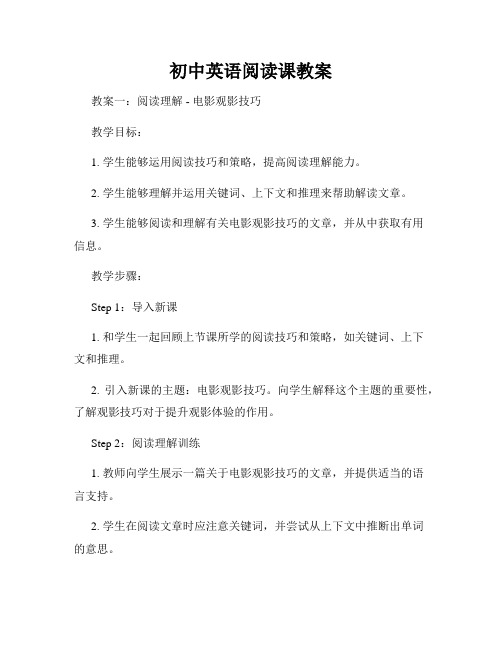
初中英语阅读课教案教案一:阅读理解 - 电影观影技巧教学目标:1. 学生能够运用阅读技巧和策略,提高阅读理解能力。
2. 学生能够理解并运用关键词、上下文和推理来帮助解读文章。
3. 学生能够阅读和理解有关电影观影技巧的文章,并从中获取有用信息。
教学步骤:Step 1:导入新课1. 和学生一起回顾上节课所学的阅读技巧和策略,如关键词、上下文和推理。
2. 引入新课的主题:电影观影技巧。
向学生解释这个主题的重要性,了解观影技巧对于提升观影体验的作用。
Step 2:阅读理解训练1. 教师向学生展示一篇关于电影观影技巧的文章,并提供适当的语言支持。
2. 学生在阅读文章时应注意关键词,并尝试从上下文中推断出单词的意思。
3. 学生可以将文章中不熟悉的单词和短语记录下来,以便后续的词汇扩展练习。
Step 3:小组合作1. 将学生分为小组,让他们讨论文章中的问题和练习。
2. 鼓励学生相互合作和交流,分享彼此的解答,以加深理解。
Step 4:全班讨论和分享1. 邀请学生分享他们的答案和解决方法。
2. 引导学生通过对比归纳总结的方式找出最佳的解题策略。
Step 5:拓展活动1. 教师可以引导学生参观电影院,了解电影放映的背后工作。
2. 学生可以编写一份电影评论,分享他们对于观影技巧的理解和应用。
教学反思与评估:通过本节课的教学,学生们能够提高自己的阅读理解能力,并应用关键词、上下文和推理来解读文章。
通过小组合作和全班讨论,学生们能够相互交流并分享彼此的解答策略。
拓展活动能够进一步激发学生的兴趣,并提高他们的观影技巧。
通过教师的评估,可以了解学生的学习成果和掌握情况。
初中英语阅读课教案模板全英文十六篇
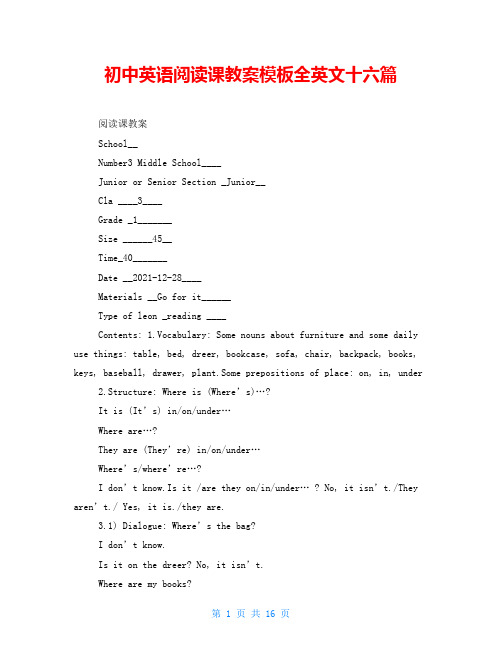
初中英语阅读课教案模板全英文十六篇阅读课教案School__Number3 Middle School____Junior or Senior Section _Junior__Cla ____3____Grade _1_______Size ______45__Time_40_______Date __2021-12-28____Materials __Go for it______Type of leon _reading ____Contents: 1.Vocabulary: Some nouns about furniture and some daily use things: table, bed, dreer, bookcase, sofa, chair, backpack, books, keys, baseball, drawer, plant.Some prepositions of place: on, in, under2.Structure: Where is (Where’s)…?It is (It’s) in/on/under…Where are…?They are (They’re) in/on/under…Where’s/where’re…?I don’t know.Is it /are they on/in/under… ? No, it isn’t./They aren’t./ Yes, it is./they are.3.1) Dialogue: Where’s the bag?I don’t know.Is it on the dreer? No, it isn’t.Where are my books?I don’t know.Are they on the bed? No, they’re not.2)Writing: ask, gue and writeObjectives:1.Instructional objectives (language knowledge and language skills)1) To promote students’ vocabulary development (table, bed, dreer, bookcase, sofa, chair, backpack, boo ks, keys, baseball, drawer, plant.…)2) To promote students’ reading skillsa) predictionb) skimming3) To promote students’ oral English4) To develop students’ writing skillcational objectives (affect, learning strategy and cultural awarene)1) To develop students’ ability to municate with others to get information2) To build students’ confidence3) To make students learn to cooperate with others3.Personal objectives: 1) To develop teacher’s ability of claroom managementFocal points: a: the nouns.b: prepositions of placec: Where- question and d: answers to “Is the… in/on/underthe …?”;Difficult points: a: use the prepositions to describe position of things b: use the where-question and Is it-/Are they -question to ask things’positionAid s: , blackboard, chalk … Procedures and Time Allotment1.Getting students ready for learning( mins)1) Greetings: Good morning everyone! 2) Routine task: duty report2.Revision: Use some pictures to review the vocabulary ( table, bed, dreer, bookcase, sofa, chair, backpack, books, keys, baseball, drawer, plant, on, in, under) and sentence structure:Where is (Where’s)…? It is (It’s) in/on/under Where are…? They are (They’re) in/on/under… 3.Pre-reading : Step1: vocabulary and some phrases learningTask: Look at the conversation between them and gue the meaning of the sentences in red.( using the conversation between Liu Qian and A _in to show those phrases to the students in order to learn them by theconte_t; because the sentence structure in the conversation is thosethey have learnt)(… mins)此步骤包括词汇、语法教学等 4.While-reading 5.Post-reading(… mins)1) Oral work2) Written work 6.Aigning homework 1) Conclusion: a: vocabularyb: sentence patterns: Where is (Where’s)…?It is (It’s) in/on/under… Where are…?They are (They’re) in/on/under… Where’s/where’re…?I don’t know.Is it /are they on/in/under… ? No, it isn’t./They aren’t./ Yes, it is./they are.2) Homework: Ask, gue and write Let your partner to ask as well as gue where your things are in your room.Write down your conversation by using the follog sentence patterns: A:where’s/where’re your…? B: You can gue.A: I don’t know.Is it /are they on/in/under… ? B: No, it isn’t./They aren’t.Yes, it is./they are.…Self-evaluationLESSON PLANTime of Leon: 45 minutes Students: Senior Grade OneTeaching Material: How Did Postage Sts e Into Use Teaching Objectives:1.To train Ss\\\\" reading ability(such as gueing the meaning of new words in the conte_t, the speed of reading.)2.To train Ss\\\\" reading prehension(To get meages from what they read.) Teaching Points:1.Ss get used to three reading skills.2.Ss understand the given paage.Properties:Sts, letters, postcards, work sheets, OHP Teaching Method: municative roach Leon Type: ReadingNew Words and A Phrase:postage, put forward, proposal, seal, deliver, system, postal Procedures: Step 1.Warm-up(6\\\\") 1.Lead-inShow some sts, letters and postcards and have free talk to arouse students\\\\" motivation.2.Dealing with some new wordsQ: Do you know the postage of a letter?E_plain "postage", and write postage on the Bb.postage: payment for the carrying of lettersA: Fifty fen for any place in China e_cept Hong Kong, Taiwan and Macao.Q: What do the postmen do with the letters?A: They take the letters from the postbo_ and carry them away tothe places on the envelopes and deliver them to the addreed people.E_plain "deliver", and write deliver on the Bb.deliver: take letters or goods to the addreed people.Q: Who put forward the proposal to use sts? Use OHP to project the question onto the screen.E_plain "put forward" and "proposal", and write them on the Bb.put forward: put an idea before people for thinking over proposal: sth.proposed, plan or idea, suggestion Again: Who put forward the proposal to use sts? Step 2.Skimming(4\\\\"30") 1.Instructions T: Now I give you a paage to read, and for the first time you should only find the answer to the question.You have only two and a half minutes to read.So don\\\\"t read word for word.Read quickly.Just try to find the answer.2.Handing out the reading material and reading3.CheckingQ: Who put forward the proposal to use sts.A: Rowland Hill, a schoolmaster in England.Step 3.Scanning(6\\\\") 1.InstructionsT: This time I give you three minutes to read the paage.When you are reading, find the answers to the two questions.Use OHP to project the questions:1.Why was the postage high in the early nieenth century when people did not use sts?2.When was postage sts first put to use? 2.Reading3.Checking 1) Pair work 2) Cla checkingAns.to Que.1.Because the post offices had to send many people to collect the postage.Ans.to Que.2.On May 6, 1840.Step 4.Full reading(21\\\\") 1.InstructionsT: Now I give you ten minutes to read the paage for the third time and you should read it carefully.Before reading, let\\\\"s go over the questions on the work sheet.Give Work Sheet 1 to the Ss.E_plain the new words in Que.4.prevent: s, not let sb.do sth.reuse: use againT: Try to find the answers to the questions.But don\\\\"t write the answers down, you can put a sign or underline the sentences concerning the questions.2.Reading3.Checking1) Group work: Checking the answers in a group of four Ss.2) Cla work: Checking the answers in cla.Poible Answers:1.Why were people unhy to pay postage for letters in the early nieenth century? Because they had to pay postage when they received letters, especially when they paid for a letter which they did not wish to receive at all.The postage was high.2.Why was it much easier for people to use sts for postage? Because people could go to the nearby post office to buy sts and put them on envelopes before they sent the letters.3.Why was the postage much lower using sts?Because in this way, the post office did not need to send postmen to collect postage.It only needed to send fewer postmen to deliver letters.4.How could the post office prevent people from reusing the sts?The post office could simply put seals on the sts so that people could not use the sts again.Check the understanding of the word "seal", and write it on the Bb.seal: ÓÊ´Á 5.Did other countries take up the new postal system? Yes.Check the understanding of "postal" and "system", and write them on the Bb.postal: of the post system: a set of working ways6.Does every country in the world has its own sts? Yes.Step 5: Rounding-off(7\\\\")1.Answering Ss\\\\" questions on the paage if any.2.Making a guided-dialogue with the information given from the paage.Hand out Work Sheet 2.Do it in pairs.3.Asking two or three pairs to read their dailogues.A poible pleted dialogue: A: Oh, What a beautiful st! B: Yes,it\\\\"s from the U.S.A..A: Do you know in the early nieenth century people did not use sts? B: Then how did they pay the postage?A: They had to pay the postage when they received letters.B: Was the postage very high then?A: Yes.Because the post offices had to send many people to collect the postage.B: Who put forward the proposal to use sts? A: Rowland Hill, a schoolmaster in England.B: Why do post offices put seals on the sts? A: They can prevent people from using the sts again.B: When did post offices begin to sell sts? A: On May 6, 1840.B: Thank you for telling me so many things about sts.Step 6.Aignment(30")Ask the Ss to shorten the paage within four or five sentences after cla, and to write it in their e_ercise books._____________________________________________________________Reading Material:How Did Postage Sts e Into UseWhen you send a letter or a postcard, you have to put sts on the envelope or on the card.When did people first begin to use sts? Who was the first to think of this idea? In the early nieenth century, peopledid not use sts.They had to pay postage when they received letters.They were unhy about this, especially when they paid for a letter which they did not wish to receive at all.The postage was high at that time,because the post offices had to send many people to collect the postage.Rowland Hill, a schoolmaster in England, was the first to putforward a proposal to use sts.He thought it would be much easier for people to use sts to cover postage.They could go to the nearby postoffice to buy sts and put them on envelopes before they sent theletters.The post office could simply put seals on the sts so that people could not use the sts again.In this way, the post office did not need to send postmen to collect postage.It only needed to send fewer postmen to deliver letters.That was a good idea and the government finally accepted it.On May 6, 1840, post offices throughout England began to sellsts.Soon this new postal system was taken up by other countries.Now each country has its own sts.And there are many people who collect sts allover the world.Work Sheet 1:Find the answers to the follog questions from the paage: 1.Whywere people unhy to pay postage for letters in the early nieenth century?2.Why was it much easier for people to use sts for postage?3.Why was the postage much lower using sts?4.How could the post office prevent people from reusing the sts?5.Did other countries take up the new postal system?6.Does every country in the world has its own sts now? Work Sheet 2:plete the dialogue with the information you have got: A: Oh, What a beautiful st! B: Yes, it\\\\"s from the U.S.A..A: Do you know ____________________people did not use sts?B: Then how did they pay the postage? A:___________________________________________________________.B: Was the postage very high then? A:___________________________________________________________.B: Who put forward the proposal to use sts? A:___________________________________________________________.B: Why do post offices put seals on the sts? A:___________________________________________________________.B: When did post offices begin to sell sts? A:___________________________________________________________.B: Thank you for telling me so many things about sts.unit 4 how do you get to school? 八年级英语阅读课教学设计【教材分析^p 】本单元以transportation 为话题设计教学内容,旨在学生使用how引导的特殊疑问句谈论how to get to places ,使学生熟练掌握描述交通方式的相关短语、句型及在句中的表达方式,掌握有关transportation 的相关词汇,同时复习一般现在时态的用法。
初中英语阅读课教案

初中英语阅读课教案
一、教学目标
1. 培养学生阅读英语的兴趣和能力。
2. 提高学生的英语语感和理解能力。
3. 帮助学生掌握一些阅读技巧和策略。
二、教学内容
1. 选择一些适合初中生阅读的英语文章。
2. 着重讲解文章中的重点词汇和句子。
3. 引导学生进行文本理解和推理等阅读能力的训练。
三、教学步骤
1. 激发学生的阅读兴趣:通过介绍有趣的英语故事或文章,引起学生的阅读兴趣。
2. 讲解文章内容:详细解读文章的主要内容,帮助学生理解文章的意思。
3. 练重点词汇和句子:通过课堂练和小组活动,帮助学生掌握文章中的重点词汇和句子。
4. 进行阅读理解练:设计一些与文章相关的问题,让学生运用阅读技巧进行理解和回答。
5. 分享阅读心得:鼓励学生分享自己的阅读感受和体会,并进行讨论。
四、教学评估
1. 给学生提供一篇新的文章进行阅读,并设计相应的问题考察学生的阅读理解能力。
2. 观察学生在课堂上的表现,包括参与度、理解能力和合作能力。
五、教学资源
1. 选择合适的英语阅读教材和练题。
2. 准备一些有趣的英语短故事或文章。
3. 准备一些课堂练和小组活动的材料。
六、教学扩展
1. 鼓励学生多读英语文章,提高阅读能力。
2. 帮助学生构建英语词汇量,扩充阅读范围。
3. 提供更多的阅读技巧和策略,帮助学生更好地理解和运用所读的英语文章。
以上是初中英语阅读课教案的内容,希望能对教学有所帮助。
初中英语阅读课教案
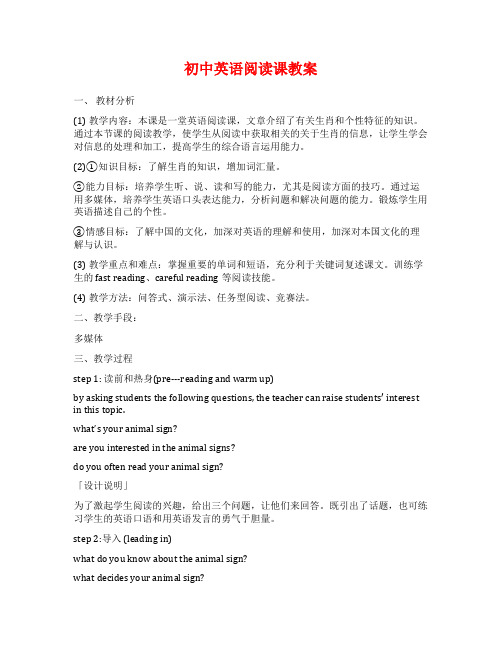
初中英语阅读课教案一、教材分析(1) 教学内容:本课是一堂英语阅读课,文章介绍了有关生肖和个性特征的知识。
通过本节课的阅读教学,使学生从阅读中获取相关的关于生肖的信息,让学生学会对信息的处理和加工,提高学生的综合语言运用能力。
(2)①知识目标:了解生肖的知识,增加词汇量。
②能力目标:培养学生听、说、读和写的能力,尤其是阅读方面的技巧。
通过运用多媒体,培养学生英语口头表达能力,分析问题和解决问题的能力。
锻炼学生用英语描述自己的个性。
③情感目标:了解中国的文化,加深对英语的理解和使用,加深对本国文化的理解与认识。
(3) 教学重点和难点:掌握重要的单词和短语,充分利于关键词复述课文。
训练学生的fast reading、careful reading等阅读技能。
(4) 教学方法:问答式、演示法、任务型阅读、竞赛法。
二、教学手段:多媒体三、教学过程step 1: 读前和热身(pre---reading and warm up)by asking students the following questions, the teac her can raise students′ interest in this topic.what’s your animal sign?are you interested in the animal signs?do you often read your animal sign?「设计说明」为了激起学生阅读的兴趣,给出三个问题,让他们来回答。
既引出了话题,也可练习学生的英语口语和用英语发言的勇气于胆量。
step 2:导入 (leading in)what do you know about the animal sign?what decides your animal sign?what are the 12 animal signs?「设计说明」通过多媒体展示12生肖的图片,初步熟悉生肖的英文名称,让学生从另一个角度来认识生肖,图片和英文名称给学生带来耳目一新的感受,从而进一步引导学生的欣赏能力,提高他们的阅读兴趣。
八年级英语阅读课教案5篇

八年级英语阅读课教案5篇八年级英语阅读课教案5篇作为一名老师,编写教案是必不可少的,编写教案助于积累教学经验,不断提高教学质量。
下面是小编为大家整理的八年级英语阅读课教案,如果大家喜欢可以分享给身边的朋友。
八年级英语阅读课教案篇1一.教材内容分析本模块以太空之旅为话题,着重介绍了火星探索以及宇宙中太阳系的部分知识。
要求同学们能够了解一些有关航天知识,用现在完成时去描述人类已经实施的太空探索。
二.学情分析在前一个模块中,学生初步掌握了利用现在完成时态谈论,旅游、看电影、看书等经历,学习了现在完成时的一般疑问句及肯定、否定的回答方法。
在本模块中,学生将继续学习yet, already, just等词在现在完成时态中的用法及have been to与have gone to之间的区别。
学习了现在完成时的一般疑问句及肯定、否定的回答方法。
人类对宇宙的探索,是否真的存在外星人,太空旅行……这些是初中生们非常感兴趣的话题,学生会觉得有话可说。
但是这一话题涉及较多的词汇,学生掌握的难度较大。
所以可能会导致学生有话想说,但却无法用英语来表达的尴尬场面。
所以在具体安排教学内容时,应适当降低难度与要求,通过开展生动有趣的活动将航天知识和语法知识深入浅出的传授给学生。
三.教学方法:直观法,小组活动法。
四.学习方法:自主学习,合作学习,探究。
五.教学目标:1.知识目标:能够掌握关于宇宙及航天的词汇;掌握现在完成时的用法2.能力目标:能听懂有关太空旅行的介绍,能够读懂有关太空话题的文章,掌握文章大意能够运用现在完成时态描述人类太空探索计划。
3.情感目标:开展生动活泼的教学活动,激发学生学习英语的兴趣。
了解中国航空事业发展,增强民族自豪感。
4.教学重点:①重点词汇:earth, just, already, station, recently, planet等.②重点句型:---Have you ….yet---Yes, I have already / just…---No, I haven’t…yet.---I have been to… He / She has gone to…5.教学难点:①用现在完成时态来描述人类已实施的太空探索计划。
初中阅读英语教案
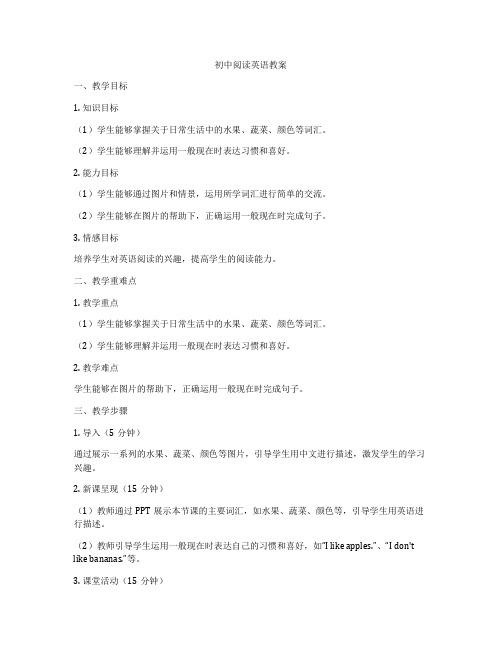
初中阅读英语教案一、教学目标1. 知识目标(1)学生能够掌握关于日常生活中的水果、蔬菜、颜色等词汇。
(2)学生能够理解并运用一般现在时表达习惯和喜好。
2. 能力目标(1)学生能够通过图片和情景,运用所学词汇进行简单的交流。
(2)学生能够在图片的帮助下,正确运用一般现在时完成句子。
3. 情感目标培养学生对英语阅读的兴趣,提高学生的阅读能力。
二、教学重难点1. 教学重点(1)学生能够掌握关于日常生活中的水果、蔬菜、颜色等词汇。
(2)学生能够理解并运用一般现在时表达习惯和喜好。
2. 教学难点学生能够在图片的帮助下,正确运用一般现在时完成句子。
三、教学步骤1. 导入(5分钟)通过展示一系列的水果、蔬菜、颜色等图片,引导学生用中文进行描述,激发学生的学习兴趣。
2. 新课呈现(15分钟)(1)教师通过PPT展示本节课的主要词汇,如水果、蔬菜、颜色等,引导学生用英语进行描述。
(2)教师引导学生运用一般现在时表达自己的习惯和喜好,如“I like apples.”、“I don't like bananas.”等。
3. 课堂活动(15分钟)(1)学生分成小组,每组选择一种水果或蔬菜,用英语进行描述,并尽量使用本节课学到的词汇。
(2)每个小组轮流进行展示,其他小组成员倾听并给予评价。
4. 阅读理解(15分钟)(1)教师分发阅读材料,学生独立阅读。
(2)学生回答阅读材料中的问题,如“What fruit does the girl like?”、“What color does the boy like?”等。
(3)教师引导学生进行讨论,分享自己的阅读心得。
5. 总结与作业(5分钟)教师对本节课所学内容进行总结,布置作业:用英语写一篇关于自己喜欢的水果、蔬菜和颜色的短文。
四、教学反思通过本节课的教学,发现学生在运用一般现在时表达习惯和喜好方面还存在一定的困难,需要在今后的教学中加强练习和巩固。
同时,学生对英语阅读的兴趣有所提高,需要在课后鼓励学生多读英语文章,提高阅读能力。
初中英语阅读教学教案大全
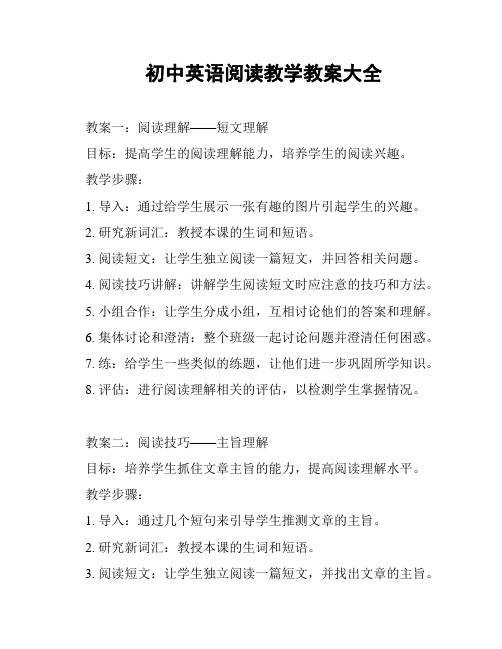
初中英语阅读教学教案大全教案一:阅读理解——短文理解目标:提高学生的阅读理解能力,培养学生的阅读兴趣。
教学步骤:1. 导入:通过给学生展示一张有趣的图片引起学生的兴趣。
2. 研究新词汇:教授本课的生词和短语。
3. 阅读短文:让学生独立阅读一篇短文,并回答相关问题。
4. 阅读技巧讲解:讲解学生阅读短文时应注意的技巧和方法。
5. 小组合作:让学生分成小组,互相讨论他们的答案和理解。
6. 集体讨论和澄清:整个班级一起讨论问题并澄清任何困惑。
7. 练:给学生一些类似的练题,让他们进一步巩固所学知识。
8. 评估:进行阅读理解相关的评估,以检测学生掌握情况。
教案二:阅读技巧——主旨理解目标:培养学生抓住文章主旨的能力,提高阅读理解水平。
教学步骤:1. 导入:通过几个短句来引导学生推测文章的主旨。
2. 研究新词汇:教授本课的生词和短语。
3. 阅读短文:让学生独立阅读一篇短文,并找出文章的主旨。
4. 主旨理解讲解:讲解学生如何确定文章的主旨,提供相关技巧和方法。
5. 小组合作:让学生分成小组,互相分享他们对文章主旨的理解。
6. 集体讨论和澄清:整个班级一起讨论文章的主旨并澄清任何困惑。
7. 练:给学生一些类似的练题,让他们进一步巩固所学知识。
8. 评估:进行主旨理解相关的评估,以检测学生掌握情况。
教案三:阅读策略——推理阅读目标:培养学生进行推理阅读的能力,提高阅读理解能力。
教学步骤:1. 导入:通过一个问题或情境激发学生进行推理阅读的兴趣。
2. 研究新词汇:教授本课的生词和短语。
3. 阅读短文:让学生独立阅读一篇带有难点的短文,并推理出相关答案。
4. 推理阅读讲解:讲解学生如何进行推理阅读,提供相关技巧和方法。
5. 小组合作:让学生分成小组,互相讨论他们的推理过程和答案。
6. 集体讨论和澄清:整个班级一起讨论推理阅读的答案并澄清任何困惑。
7. 练:给学生一些类似的练题,让他们进一步巩固所学知识。
8. 评估:进行推理阅读相关的评估,以检测学生掌握情况。
初中英语教案阅读课王蔷

初中英语教案阅读课王蔷教案标题:初中英语阅读课教案——王蔷教案目标:通过阅读课的教学,使学生能够:1. 提高对英语阅读材料的理解能力;2. 掌握阅读技巧,如推理、推断、解释等;3. 培养学生的阅读兴趣和自主学习能力;4. 了解和学习王蔷的成功故事。
教学重点:1. 学习并理解阅读材料中的关键信息;2. 学习阅读技巧,并能运用到实际阅读中;3. 通过阅读王蔷的成功故事,激发学生的进取心和学习动力。
教学准备:1. 王蔷的成功故事相关阅读材料;2. 学生课本及练习册;3. 多媒体设备。
教学过程:步骤一:导入(5分钟)1. 呈现一张王蔷的照片,让学生观察并描述她的特点;2. 引导学生回顾和讨论一下王蔷是谁,有什么成就和贡献。
步骤二:阅读前准备(10分钟)1. 教师简要介绍阅读材料的主题和内容,激发学生的学习兴趣;2. 提出几个问题,让学生思考并预测阅读材料的可能内容。
步骤三:阅读理解(15分钟)1. 学生独立阅读相关材料,并标记出关键信息;2. 学生在小组内交流阅读理解,并解答老师提出的问题;3. 教师引导学生讨论并思考某些问题的答案。
步骤四:阅读技巧讲解(10分钟)1. 教师介绍一些提高阅读理解能力的技巧,如推理、推断、解释等;2. 引导学生运用这些技巧来理解和解释阅读材料。
步骤五:小组活动(15分钟)1. 将学生分成小组,每组就一段阅读材料展开讨论和研究;2. 学生彼此交流各自的理解和分析,并互相提出问题。
步骤六:课堂讨论(10分钟)1. 学生展示他们小组的研究成果,分享对阅读材料的理解和思考;2. 教师带领全班讨论,解答学生可能存在的疑问。
步骤七:延伸拓展(10分钟)1. 学生自主阅读其他与王蔷相关的材料,并写下自己的阅读心得;2. 学生分享各自的心得和感受,并进行展示。
步骤八:课堂总结(5分钟)1. 教师总结本节课的学习内容和重点;2. 鼓励学生在以后的阅读学习中多运用阅读技巧,提高阅读能力。
教学反思:本节课通过引入王蔷的成功故事,激发了学生的学习动力和兴趣。
初中英语阅读课教案
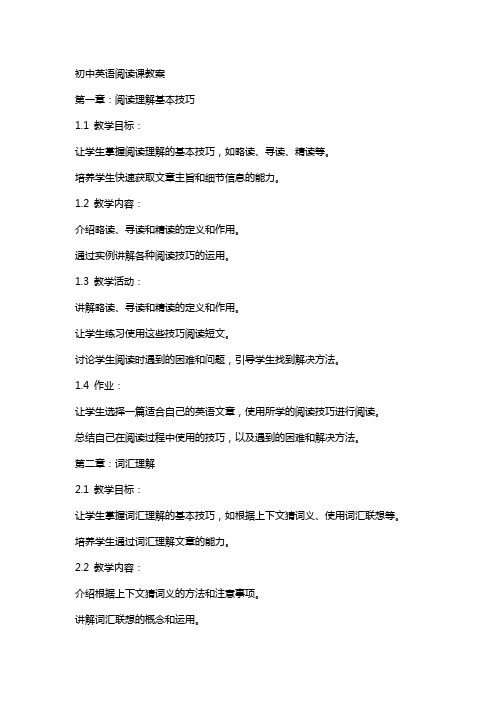
初中英语阅读课教案第一章:阅读理解基本技巧1.1 教学目标:让学生掌握阅读理解的基本技巧,如略读、寻读、精读等。
培养学生快速获取文章主旨和细节信息的能力。
1.2 教学内容:介绍略读、寻读和精读的定义和作用。
通过实例讲解各种阅读技巧的运用。
1.3 教学活动:讲解略读、寻读和精读的定义和作用。
让学生练习使用这些技巧阅读短文。
讨论学生阅读时遇到的困难和问题,引导学生找到解决方法。
1.4 作业:让学生选择一篇适合自己的英语文章,使用所学的阅读技巧进行阅读。
总结自己在阅读过程中使用的技巧,以及遇到的困难和解决方法。
第二章:词汇理解2.1 教学目标:让学生掌握词汇理解的基本技巧,如根据上下文猜词义、使用词汇联想等。
培养学生通过词汇理解文章的能力。
2.2 教学内容:介绍根据上下文猜词义的方法和注意事项。
讲解词汇联想的概念和运用。
2.3 教学活动:讲解根据上下文猜词义的方法和注意事项。
让学生练习使用词汇联想阅读短文。
讨论学生阅读时遇到的困难和问题,引导学生找到解决方法。
2.4 作业:让学生选择一篇适合自己的英语文章,使用所学的词汇理解技巧进行阅读。
总结自己在阅读过程中使用的技巧,以及遇到的困难和解决方法。
第三章:推理判断3.1 教学目标:让学生掌握推理判断的基本技巧,如通过文章中的细节信息进行推理、判断作者的观点等。
培养学生通过推理判断理解文章的能力。
3.2 教学内容:介绍通过文章中的细节信息进行推理的方法和注意事项。
讲解判断作者观点的方法和注意事项。
3.3 教学活动:讲解通过文章中的细节信息进行推理的方法和注意事项。
让学生练习使用推理判断技巧阅读短文。
讨论学生阅读时遇到的困难和问题,引导学生找到解决方法。
3.4 作业:让学生选择一篇适合自己的英语文章,使用所学的推理判断技巧进行阅读。
总结自己在阅读过程中使用的技巧,以及遇到的困难和解决方法。
第四章:阅读策略4.1 教学目标:让学生掌握常用的阅读策略,如预测、归纳、总结等。
初三英语阅读课教案
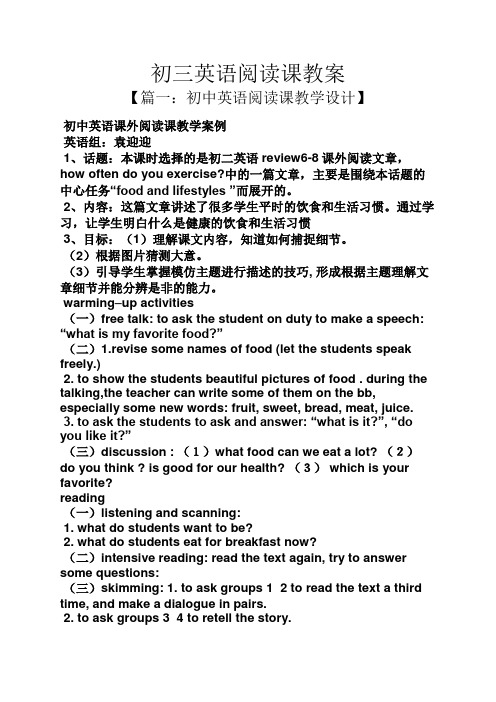
初三英语阅读课教案【篇一:初中英语阅读课教学设计】初中英语课外阅读课教学案例英语组:袁迎迎1、话题:本课时选择的是初二英语review6-8课外阅读文章,how often do you exercise?中的一篇文章,主要是围绕本话题的中心任务“food and lifestyles ”而展开的。
2、内容:这篇文章讲述了很多学生平时的饮食和生活习惯。
通过学习,让学生明白什么是健康的饮食和生活习惯3、目标:(1)理解课文内容,知道如何捕捉细节。
(2)根据图片猜测大意。
(3)引导学生掌握模仿主题进行描述的技巧, 形成根据主题理解文章细节并能分辨是非的能力。
warming–up activities(一)free talk: to ask the student on duty to make a speech: “what is my favorite food?”(二)1.revise some names of food (let the students speak freely.)2. to show the students beautiful pictures of food . during the talking,the teacher can write some of them on the bb, especially some new words: fruit, sweet, bread, meat, juice.3. to ask the students to ask and answer: “what is it?”, “do you like it?”(三)discussion : (1)what food can we eat a lot? (2)do you think ? is good for our health? (3) which is your favorite?reading(一)listening and scanning:1. what do students want to be?2. what do students eat for breakfast now?(二)intensive reading: read the text again, try to answer some questions:(三)skimming: 1. to ask groups 1 2 to read the text a third time, and make a dialogue in pairs.2. to ask groups 3 4 to retell the story.(四)extension activity: to ask the students to tell something about their own lifestyles.反思在教学实践中,体会到,阅读教学应处理好以下四个关系:1:教师的“教”和学生的“学”的关系。
初中阅读教案英语

初中阅读教案英语
1. 知识目标
(1)能够掌握本课的生词和短语。
(2)能够理解并运用本课所学的重点句型。
(3)能够理解并描述故事情节。
2. 能力目标
(1)能够用英语进行简单的日常交流。
(2)能够阅读并理解简单的英语故事。
3. 情感目标
培养学生的团队协作精神,提高学生的自信心和自主学习能力。
二、教学重难点
1. 教学重点
(1)本课的生词和短语。
(2)本课所学的重点句型。
(3)故事情节的理解和描述。
2. 教学难点
(1)生词和短语的理解和运用。
(2)重点句型的运用。
三、教学过程
1. 热身(5分钟)
通过简单的英语歌曲或游戏,让学生放松心情,进入学习状态。
2. 课堂导入(10分钟)
利用图片或情境,引入本课的主题,激发学生的兴趣。
3. 课堂讲解(20分钟)
(1)教授生词和短语,让学生通过例句理解并记忆。
(2)教授重点句型,让学生通过练习掌握。
(3)讲解故事情节,让学生理解并能够描述。
4. 课堂实践(15分钟)
通过小组活动或角色扮演,让学生运用所学知识进行实际操作。
5. 总结与作业布置(10分钟)
对本课内容进行总结,布置作业,让学生巩固所学知识。
四、教学评价
通过课堂表现、作业完成情况和课堂实践成果,对学生的学习情况进行评价。
五、教学反思
在课后,教师应认真反思本节课的教学效果,针对学生的学习情况,调整教学方法和策略,以提高教学效果。
- 1、下载文档前请自行甄别文档内容的完整性,平台不提供额外的编辑、内容补充、找答案等附加服务。
- 2、"仅部分预览"的文档,不可在线预览部分如存在完整性等问题,可反馈申请退款(可完整预览的文档不适用该条件!)。
- 3、如文档侵犯您的权益,请联系客服反馈,我们会尽快为您处理(人工客服工作时间:9:00-18:30)。
初中英语阅读课教案集【篇一:初中英语阅读课教学设计】谈初中英语阅读课教学案例吉林省桦甸市金沙中学:王欣平一、背景现行初中英语教材具有很多的优点,但由于学生认知水平的发展具有规律性,教师只有充分认识和掌握这种规律,并结合教学实际,合理设计教学程序,充分发挥学生的主体作用,教学相长,才能达到教学效果的最优化。
二、教材分析1、话题:本课时选择的是初二英语课本第四单元 how often doyou exercise?中的一篇文章,主要是围绕本单元的中心任务“food and lifestyles ”而展开的。
2、内容:这篇文章讲述了很多学生平时的饮食和生活习惯。
通过学习,让学生明白什么是健康的饮食和生活习惯3、目标:(1)理解课文内容,知道如何捕捉细节。
(2)根据图片猜测大意。
(3)引导学生掌握模仿主题进行描述的技巧, 形成根据主题理解文章细节并能分辨是非的能力。
step 1: warming–up activities(一)free talk: to ask the student on duty to make a speech: “what is my favorite food?”设计思路:以讨论日常生活的话题进入,可以活跃课堂气氛。
同时,由于每天都有值日生报告,可以锻炼学生的书写和口头表达能力。
另外,在交流过程中,也互相锻炼了学生的听力水平。
(二)1.revise some names of food (let the students speak freely.)2. to show the students beautiful pictures of food during the talking,the teacher can write some of them on the bb,especially some new words: fruit, sweet, bread, meat, juice.3. to ask the students to ask and answer: “what is it?”, “doyou like it?”设计思路:(1)通过感性的图片教学,可以进一步调动学生的学习积极性。
(2)让学生相互问答,了解食物的名称,在交流中培养他们的合作精神和解决问题的能力。
(三)discussion : (1)what food can we eat a lot? (2)do you think ? is good for our health? (3) which is your favorite?设计思路:通过有趣的话题极大地激发学生的好奇心,为进入正文教学打下基础。
最后向学生展示有关食物的相关链接(p67)-- “healthy eating”,并让他们参与讨论,知道哪些才是正确的饮食。
教学后记:针对上述教学设计和课堂教学活动,笔者有以下三点体会:(1)本活动在设计上比较符合学生的认知水平,能激发学生完成任务的兴趣和参与活动的热情。
(2)能使阅读前的“warming–up activities”真正发挥“热身”的作用。
这就为顺利开展之后的多个活动打下了基础。
(3)上课伊始就顺利切入主题,中间过渡自然,言语富有鼓励性和启发性,能使学生产生强烈的共鸣。
step 2: reading(一)listening and scanning:1. what do students want to be?2. what do students eat for breakfast now?设计思路:(1) 听和读都是学生获取信息的有效途径。
通过让学生边听边读(默读)可以培养其快速阅读的能力。
(2)通过有目的地听和读,让学生在了解课文大意的同时握课文中一些细节性的内容。
(二)intensive reading: read the text again, try to answersome questions:设计思路:进一步有目的地读,可以让学生更好地了解课文细节。
同时,通过抢答加分的方式,进一步激发学生的主动参与性。
(三)skimming: 1. to ask groups 1 2 to read the text a third time, and make a dialogue in pairs.2. to ask groups 3 4 to retell the story.设计思路:1、让学生进一步阅读课文,了解文章的内容,通过对话培养学生交流与合作能力。
2、通过文章改写与复述培养学生运用语言的能力。
(四)extension activity: to ask the students to tell something about their own lifestyles.设计思路:学以致用,自己的话题会让他们产生更大的兴趣。
同时,通过这项活动可以充分训练学生的综合技能。
四、教学后记针对上述教学设计和具体的教学活动,本人事后有以下几点思考:1、比赛是学生比较喜欢的学习方式。
以竞赛形式贯穿整个教学活动是该部分教学设计的亮点。
在比赛过程中,学生反应积极,讨论热烈,思维活跃,竞争激烈,教学效果比较令人满意。
同时在教学过程中,充分并合理安排学生的合作活动,让他们在合作探究中共同提高,收到了较好的效果。
2、只有通过阅读才能让学生理解课文内容,并形成一定的阅读技能。
本环节通过“提炼大意,情节捕捉,合作探究和延伸训练”四个步骤,培养学生概括主题、捕捉细节和再现阅读内容的技能。
教师同时能注意设计合适的衔接语言,使各个教学环节自然过渡,让学生在不知不觉中进入学习状态并开展活动。
3、教师在教学过程中积极调动学生,让学生自己来组织并完成任务,真正体现了学生的主体地位。
五、反思在教学实践中,本人也体会到,阅读教学应处理好以下四个关系:1:教师的“教”和学生的“学”的关系。
教师应更多地关注如何教会学生阅读,而不是仅向学生灌输大量的语言知识。
教学过程是学生在教师的帮助和指导下掌握知识和形成技能的过程。
教师应让学生在活动中发挥其主体地位,让学生自己去发现问题、分析问题和解决问题。
2、在教学设计过程中,要尽最大可能考虑学生情感在教学中的重要性,要设法让学生在快乐中学习。
但教师不能片面地追求所谓的“快乐”,一味强调热闹课堂,气氛是活跃了,但忽视了学生对知识的掌握和能力的培养。
3、阅读过程与结果的关系。
任务型教学要求教师在教学中不仅要关注学习的结果,还要关注学习的过程。
学生完成任务的过程就是学生发现问题、分析问题和解决问题的过程。
同时也是逐步提升阅读技巧,提高阅读能力的过程。
4、实践和反思的关系。
反思是实践的一面镜子,每次的教学反思都能折射出实践中的成功和不足之处。
在教学中应该不断借鉴成功,改进不足,把培养学生学会阅读、学会自主学习作为追求的目标。
【篇二:初中牛津英语阅读课教学设计】初中牛津英语阅读课的教学设计初中英语阅读教学已占主导地位,优化阅读课的教学设计能提高阅读课的教学效果和培养学生的综合运用语言能力。
那么,如何优化初中英语阅读课的教学设计?本文试以fun with english 7b unit3中的 reading 部分a lucky escape 为例,对此作一探讨。
一、精心设计问题,设置悬念,激发阅读兴趣在初中英语阅读教学中,设计问题,回答问题是课堂教学使用率最高的一种教学手段。
教师问题设计的得体、精巧,能把学生引入“问题情境”,激发学生探索知识和阅读的欲望,引导他们积极思考,对发展学生的英语表达能力能起到极大作用。
在初中英语阅读教学的问题设计中,教师要注意提问的质量,问题要有启发性,且难易适度,要有训练思维能力的价值,对不同性质不同程度的问题要适当地让不同程度的学生回答。
据此,教师在设计问题时,要精心组织,甚至对某个问题学生可能有的几种回答怎么引导,怎么分析都要在事先有所估计,有所考虑。
另外,设计问题时要注意循序渐进,由易到难。
首先提出能让学生通过略读就能快速在语篇中找到明显答案的连贯的问题,帮助他综观全文,获取对语篇的完整印象,训练学生整体理解,快速阅读的技能;然后提出一些推断性问题让学生通过精读领会语篇的细节,根据问题迅速定位,在区域内进行合理的判断、推测,培养他的分析、综合和概括等思维能力;最后,提出一些延伸性问题来开拓学生的视野,培养创造性思维。
二、合理安排教学步骤,有层次地引导学生阅读【篇三:初中英语阅读课教学设计与反思】初中英语阅读课教学设计与反思单县蔡堂职业中学赵艳一、教材分析1、话题:本课时选择的是初二英语课本第一单元 how often doyou exercise?中的一篇文章,主要是围绕本单元的中心任务“food and lifestyles ”而展开的。
2、内容:这篇文章讲述了很多学生平时的饮食和生活习惯。
通过学习,让学生明白什么是健康的饮食和生活习惯3、目标:(1)、理解课文内容,知道如何捕捉细节。
(2)、根据图片猜测大意。
(3)、引导学生掌握模仿主题进行描述的技巧、形成根据主题理解文章细节并能分辨是非的能力。
step 1: warming –up activities(一)、free talk : to ask the student on duty to make aspeech : “what is my favourite food ?”设计思路:以讨论日常生活的话题进入,可以活跃课堂气氛,同时,由于每天都有值日生报告,可以锻炼学生的书写和口头表达能力,另外,在交流过程中,也互相锻炼了学生的听力水平。
(二)、1.revise some names of food(let the students speak freely.)2. to show the students beautiful pictures of food during the talking the teacher can write some of them on the bb,especially .some new words: fruit, sweet, bread, meat, juice.3. to ask the students to ask and answer what is it “do youlike it ?”设计思路:(1)、通过感性的图片教学,可以进一步调动学生的学习积极性。
(2)让学生相互问答,了解食物的名称,在交流中培养他们的合作精神和解决问题的能力。
(三)、discussion : (1)what food can we eat a lot ? (2)do you think … is good for our health ? (3) which is your favorite ?设计思路:通过有趣的话题极大地激发学生的好奇心,为进入正文教学打下基础。
